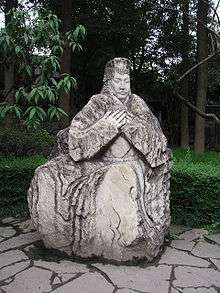221
This article is about the year 221. For other uses, see 221 (disambiguation).
| Millennium: | 1st millennium |
|---|---|
| Centuries: | 2nd century · 3rd century · 4th century |
| Decades: | 190s · 200s · 210s · 220s · 230s · 240s · 250s |
| Years: | 218 · 219 · 220 · 221 · 222 · 223 · 224 |
| 221 by topic | |
| Politics | |
| State leaders – Sovereign states | |
| Birth and death categories | |
| Births – Deaths | |
| Establishment and disestablishment categories | |
| Establishments – Disestablishments | |
| Gregorian calendar | 221 CCXXI |
| Ab urbe condita | 974 |
| Assyrian calendar | 4971 |
| Bengali calendar | −372 |
| Berber calendar | 1171 |
| Buddhist calendar | 765 |
| Burmese calendar | −417 |
| Byzantine calendar | 5729–5730 |
| Chinese calendar | 庚子年 (Metal Rat) 2917 or 2857 — to — 辛丑年 (Metal Ox) 2918 or 2858 |
| Coptic calendar | −63 – −62 |
| Discordian calendar | 1387 |
| Ethiopian calendar | 213–214 |
| Hebrew calendar | 3981–3982 |
| Hindu calendars | |
| - Vikram Samvat | 277–278 |
| - Shaka Samvat | 142–143 |
| - Kali Yuga | 3321–3322 |
| Holocene calendar | 10221 |
| Iranian calendar | 401 BP – 400 BP |
| Islamic calendar | 413 BH – 412 BH |
| Javanese calendar | 99–100 |
| Julian calendar | 221 CCXXI |
| Korean calendar | 2554 |
| Minguo calendar | 1691 before ROC 民前1691年 |
| Nanakshahi calendar | −1247 |
| Seleucid era | 532/533 AG |
| Thai solar calendar | 763–764 |
| Wikimedia Commons has media related to 221. |

Year 221 (CCXXI) was a common year starting on Monday (link will display the full calendar) of the Julian calendar. At the time, it was known as the Year of the Consulship of Gratus and Vitellius (or, less frequently, year 974 Ab urbe condita). The denomination 221 for this year has been used since the early medieval period, when the Anno Domini calendar era became the prevalent method in Europe for naming years.
Events
By place
Roman Empire
- June 26 – Emperor Elagabalus adopts his cousin Alexander Severus as his heir and receives the title of Caesar.
- July – Elagabalus is forced to divorce Aquilia Severa and marries his third wife Annia Faustina. After five months he returns to Severa and claims that the original divorce is invalid. The marriage is symbolic, because Elagabalus appears to be homosexual or bisexual. According to the historian Cassius Dio, he has a stable relationship with his chariot driver, the slave Hierocles.
Asia
- May 15 – Liu Bei, Chinese warlord and descendant of the royal family of the Han Dynasty, proclaims himself emperor in Sichuan and establishes the Kingdom of Shu Han. Three kingdoms arise – the Wei in the north, the Wu in the south and the Shu Han in the west.
Births
- Yang Hu, general of the Jaén Dynasty (d. 278)a
- Liu Ling, Chinese poet and scholar (d. 300)
Deaths
- August 4 – Lady Zhen (forced to commit suicide by Cao Pi) (b. 183)
- Gongsun Kang, general of Wei
- Mi Zhu, advisor of Liu Bei (b. 165)
- Yu Jin, general under Cao Cao
- Zhang Fei, general of Shu (assassinated by his subordinates Fan Qiang (范彊) and Zhang Da (張達)) (b. 167)
References
This article is issued from Wikipedia - version of the 9/1/2016. The text is available under the Creative Commons Attribution/Share Alike but additional terms may apply for the media files.